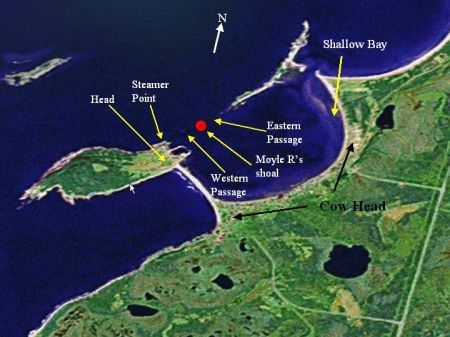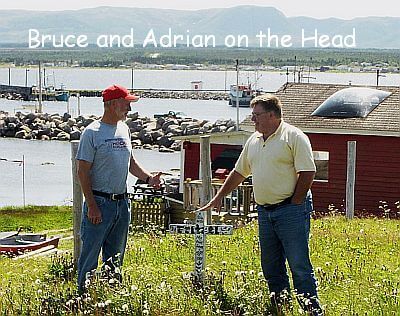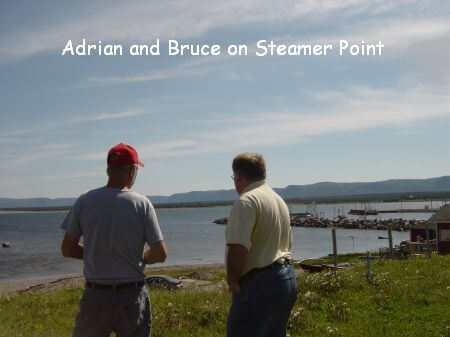This is the story of a shipwreck of one of the coastal boats, the Moyle R, which was delivering freight along the coast of the Great Northern Peninsula of Newfoundland Labrador. She sailed during the 1950’s along with the coastal boats The Northern Ranger and the Springdale. The Moyle built in 1942 by McKay & Sons in Shelbourne, Nova Scotia, was 112.6 feet in length with a gross tonnage of 150. She was a wooden vessel with an oil engine. The Moyle R arrived at Cow Head laden with freight from Corner Brook in December of 1954. I was 14 at the time. In 1954, there were no roads, telephones, television or electricity, in the area of Cow Head. The only means of communication was wireless telegraphy. In many instances, if a person wanted to relay a message to friends or family, they would send it to the local radio station (CBC) and had it aired over during a news broadcast called the Gerald S. Doyle Bulletin.
There was a coop store in Cow Head and they would pay us 25 cents per hour to help unload the freight. And we were more than happy to help! Back then, there was no wharf in the harbour and the cargo designated for Cow Head would be loaded into a scow, which was towed out to the ship with a motorboat, and brought to the beach where it would be unloaded and carried to the coop store. The coop store was located on what we now refer to as the “Head” and was located where H.H. Hopkins now has their fish plant.
It was late in the evening, that day in December 1954, when the freight was finally unloaded, and darkness had descended. With his cargo unloaded at Cow Head, Moyle R’s Captain Gillette inquired if there might be a couple of young men interested in sailing on the ship, – as he was short a couple of deck hands. When the Moyle R weighed anchor and made ready to leave Cow Head, it had two men from Cow Head as sailors – Leo Hynes and his brother, Hubert Hynes. It was a job they would not soon forget!

The ship was no more than 500 meters from shore when it hit a shoal. A crowd began to gather at Steamer Point when we realized what had happened to the boat. We watched until 11 or 12 o’clock but there was nothing we could do. At that time, my family lived in a red two-story house and my bedroom window faced the harbour. I remember seeing the boat from there. It was trying to get off the rocks and when the captain gave her full power, you could actually see the fire coming out of the boats’ smokestack. This was quite the sight at that time, as you can imagine, because we were pretty isolated and didn’t get to see too many incidents like this. Here was a boat over 100 feet in length, weighing in near 150 tons and the more power that the captain gave her, the more stuck she became. Some people stayed up all night to watch.
The next morning, there was a wicked gale of wind blowing and the boat was still stranded. It was actually blowing too hard for the crew of 12 of the Moyle R to launch their lifeboats.
The safety of that crew became a major concern for the whole community. Some of the older men in the community decided that they would tie together all the rope that they could find, tie it to the scow that was used for landing the freight and try to get the scow to the crew. The men on shore could then pull them in. After about a half dozen attempts, the men on shore finally got the scow close enough to the Moyle R that the crew were able to reach it. I remember that the teacher let all of us boys out of school and we were right there along with the men of the community. We were so anxious to get the crew ashore; we began pulling as hard as we could and because the winds were so high, we almost pulled the scow in under the water. Upon realizing this, we slowed down considerably and were successful in getting everyone safely to shore. The crew and the community were quite happy about this, as you can imagine, and everyone celebrated.
The boat had obviously punctured a hole in its bottom when it went aground on the rocks, but it did not break apart. Very shortly thereafter, a high tide lifted the boat of the rock and it drifted farther down in the harbour. The bottom was ripped up pretty good and was beyond repair.
Eventually, the freight that was still on the Moyle R that that was designated for othercommunities began drifting ashore, including 100 quarters of fresh beef along with 100 barrels of salt beef (200 pounds per barrel), that had been sitting on the deck. When the people of the community saw this happening, they began devising ways of salvaging these items. There was hardly a man that wasn’t out in his boat trying to jig up the quarters of beef and the barrels of salt beef Even though the beef had been in salt water, when the outer layer was trimmed off, it was perfectly okay.
With time, the cartons in the boat holds were soaked enough that some of the contents were coming afloat and being washed upon the beach. Barrels of apples, full bologna and just about anything you could mention were washing upon the beaches and almost everyone in the community and surrounding area were taking advantage of it. Some people even came after dark with horse and sled. This was probably the last boat for the season before the drift ice came and the merchants had ordered up a good supply because it had to carry them through the winter months until the boats were able to sail again in the spring. As you can imagine, it was well stocked with food supplies, along with building materials. I remember that my father and I picked up several large bologna and 12 or 15 barrels of apples. We’d save about two dozen apples from each barrel that weren’t contaminated with oil because by this time the fuel was beginning to leak from the boat and wash to the surface.
There was lots of things picked up that we weren’t use to having back in the fifties and people were eager to pick up all they could get of it.
At this time of year, a good number of the community’s men were away either working in the woods with Bowaters at Hawkes Bay or Deer Lake or working at their own private sawmills in the backwoods. There was one lady in particular that wanted to let her husband (who was working away) know about the shipwreck and all the things washing ashore on the beach that people were picking up and bringing home. But, off course, she didn’t really want the whole coast to know about it, and she didn’t want to alarm her husband, so when she sent him a telegram it read as follows: “Come quick. Nobody sick. All around shore.” I’m certain it brought a chuckle to those who understood what she was trying to convey to her husband and bewilderment to those who didn’t.
As far as I can recall, this message was broadcast over the air on a radio program called the Woodland Echos. Bowaters who owned the paper mill in Comer Brook sponsored this program. It was aired every Friday evening on CBC radio. The host of the hour long show played country music, jigs and reels. The company designed this program for the loggers who were working in the lumber camps. It supplied the loggers with some much-needed entertainment and was a means whereby wives and mothers could relay messages to their husbands and sons because at that time there were no telephones.
I remember some amusing messages being aired on both the Woodland Echos and the Gerald S. Doyle Bulletin For example, there was a man who went to Corner Brook to pick up a stove that he had ordered but it had not yet arrived. So he sent the following message to his wife, “Won’t be home tonight; hung up over stove”. Another one sent by Saul in the lumber camp to his wife at home read, “Left camp 7. Gone to camp 11. Love to all. Signed Saul”. Even though times were hard and people worked hard, I think they had a great sense of humour, which I’m sure, helped them through many difficult situations.
The crew of the Moyle R remained in Cow Head for a couple of weeks before a boat arrived to take them home. That was the only means of transportation besides the dog team and horse and sleigh in winter. They were distributed around the community while waiting for a boat to come for them. I recall that the cook stayed with my uncle, Tom Payne. Some of the older people thought he was a witch because of some of the tricks he could do. He happened to be a bit of a magician and he had all kinds of tricks that he used to show us along with dozens of card tricks.
We were very anxious for him to teach us some of these tricks, which he did. One that I recall was a trick with a box of matches. I guess he sliced the top of the matchbox and pasted one part of it with the label of a package of camel cigarettes. When he showed us the camel packaging, he appeared to be extracting a cigarette from it (which he had hidden in his hand). Then he’d haul his hand down over the box and it would appear to be a box of matches. Because we were young and lived in isolation, we were very impressed and couldn’t wait for him to show us how it was done so that we could practice on our siblings and friends. After many attempts and lots of practicing, I was finally able to get them perfected to a tee and was more than happy to show my friends what a great magician I was.
Being an isolated community in which very little happened, the wreck of the Moyle R was a major event in which everyone was involved in one way or another. Things continued to drive in along the shore and people were scrambling to salvage them. After some time had passed, the residents realized that by now the cartons that were stored in the ships’ hold must be soaked and they began to think of ways that they could get at the contents. Someone came up with the idea of making very large dip-nets that could be used to scoop the contents from the ships’ hold. These large dip-nets were designed with a long handle on one side and a length of rope on the other.
There were two large hatches on the ship that were accessible to the hold and one man would stand on either side of the hatch. One would push the dip-net down into the hold as far as he could get it and the man on the other side would begin pulling it up by the rope that was attached.
Each dip-net that came up was a surprise. There would be cheese whiz, Budweiser beer, all kinds of canned goods and almost anything you could mention. I believe this was the first time I’d ever seen cheese whiz and it was a real treat to us. My father and I were involved in this and we would have our turn using the dip-net along with everyone else. Off course, after a few days when the news got around that we were doing this, we had people coming from Sally’s Cove, St. Paul’s, Parsons Pond and Daniel’s Harbour to get a share of the contents. There were lots to go around and Cow Head welcomed them. Messages continued to be sent to relatives working away and there was always someone returning to get in on the action. There was quite a show going on here for a while.
Most of the canned goods that were salvaged had, off course, the labels soaked of them because they had been in the water so long. Almost always when you opened a can it would be a surprise; you never knew for sure what you were going to get. I remember y brother-in-law opening what he thought was a can of fruit and instead it was a can of tar. Imagine having that stuck to your teeth! There were quite a few incidents like this until everyone began to figure out what was in a particular can. Cans were recognized by their shape and size, the numbers stamped on them, the rings around them and the colour.
Once people had salvaged most of the food that was on the Moyle R, their thoughts turned to the salvage of equipment that they thought the ships’ owners would be interested in paying for. I recall that two of my brothers-in-law, Freeman Payne and George Hewlin, went aboard the ship and salvaged the ship to shore (radio), radar and all the navigational equipment. I also remember that Leo Hynes and myself salvaged about a dozen sets of oars belonging to the lifeboats and two containers of survival goods, which included biscuits and condensed milk. The people who were taking all of these things thought it was legitimate to be doing so and did not think upon it as stealing but, the owners of the ship thought otherwise. Some of them came to Cow Head and informed us that we would have to give up the goods that we had salvaged but we were reluctant to do that because we felt we had the right to keep it since we had salvaged it. Although there was a salvage man in Cow Head, George Hutchings, the main salvage office was in Bonne Bay.
My brothers-in-law, Freeman and George decided that they would take the equipment that they had salvaged to the main salvage office in Norris Point believing that they would get paid for it.
Because there were no roads at the time, they had to walk, so of they went with all of this equipment on a small sled called a coaster. There were quite a number of men and boys who were involved in this salvage but as I recall no one was paid for any of the things that they recovered.
While all of this was going on, I had one of the ships’ owners come to my home to talk to me. My mother answered his knock and when she came looking for me she was very worried. She said, ” My God, Adrian, what have you done now?” Off course, I had never been in any kind of trouble before but she was kind of upset because of everything that had been going on in the community. The man who came to see me probably expected to break me down because I was young but I would not tell on my friends and they were happy that I didn’t and gave me a lot of credit for keeping quiet.
Approximately a year and a half later, Mr. Gus Payne purchased the boat. He succeeded in re-floating it. He purchased about 50 thousand board feet of lumber from a local sawmill operator and when the tide was low, he filled the ships’ holds with it. When the tide rose, the lumber caused the ship to float and Mr. Payne had it towed into the harbour. Shortly thereafter, another ship came to Cow Head and towed the Moyle R to dry dock. It’s my understanding that the ship was refitted and resumed it’s sailing along the coast of Newfoundland.
This, basically, is the story as I remember it and a story worth telling. It is a part of our heritage and I think it needs to be told to the next generation.
*Adrian owns Big Mountain Outfitters in Cow Head.

Bruce’s note to this story: I was in Cow Head on July 1, 2005 launching my new book, The SS Ethie and the Hero Dog. I met Adrian Payne and spent some time at this home listening to the story of the Moyle R and other interesting tales. The story presented above is almost entirely in Adrian’s own words. In the 1950’s when Canada was building the St. Lawrence Seaway, the Trans-Canada Pipeline, and the Trans- Canada Highway, small towns on the west coast of Newfoundland had no roads. While we, in most of Canada, were marveling over the new invention called television, many small towns on the Northern Peninsula were without electricity. These people of the Northern Peninsula were hearty and resourceful people. When a ship foundered and was abandoned near their town, they made the best of it.

Gerald Jennings
Enjoyed your story. The Moyle R was captained by my grandfather and named after him. When it was sold he went on to
Captain the M/V OK Service 5 in Lahave ,NS. for many years. Both ships were almost identical but the OK5 was a few feet shorter in length.
Tom Caines
A fantastic, well written story!!!
Anna
Dear Adrian and Bruce, I really enjoyed reading your account of the moyle. I am doing some research on this wreck and it would be great to speak to either of you in more detail. Many thanks, Anna